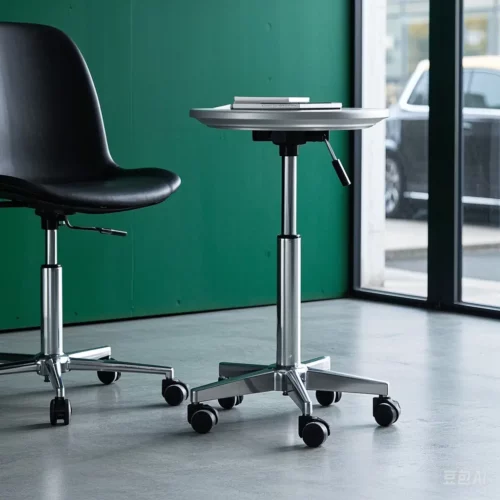Heavy-Duty Height Adjustable Castors: A Deep Dive into Engineering and Technical Advantages
Heavy-duty height adjustable castors are essential tools in modern industry, designed to move heavy loads efficiently and safely. These castors combine strength, versatility, and ergonomic design, making them ideal for various applications, from manufacturing and warehousing to healthcare and logistics. This article explores the engineering behind these castors, their benefits, real-world applications, and future trends.
What can castors adjustable height be used for? To what extent can it be used?
Adjustable height castors are designed to provide flexibility and stability in a variety of applications. They can be used to level equipment on uneven surfaces, adjust the working height of machinery, and enhance the mobility of furniture or industrial equipment. These castors are particularly useful in industrial settings for stabilizing heavy machinery, ensuring precise alignment of equipment, and reducing vibrations.
They are also employed in furniture applications, such as adjustable workstations, mobile storage units, and display stands, to improve functionality and accessibility. Additionally, adjustable height castors can be found in laboratory settings for sensitive instruments, in outdoor environments for patio furniture and plant stands, and in accessibility solutions for ramps and platforms. The extent of their use ranges from lightweight applications, like office furniture, to heavy-duty industrial equipment, with some models supporting loads up to 700 kg

The Importance of Heavy-Duty Castors
In industrial settings, moving heavy equipment and materials quickly and safely is crucial. Heavy-duty castors play a vital role by providing reliable mobility. Their importance has grown with the increasing complexity of modern manufacturing and logistics operations.
Evolution of Castors
Castors have evolved from simple wooden wheels to sophisticated engineering solutions. Early castors were limited in load capacity and maneuverability, but the Industrial Revolution spurred the development of stronger metal castors. Today, heavy-duty castors are designed to handle significant loads and harsh environments, with features like height adjustability addressing the challenges of uneven surfaces.
Need for Height Adjustability
In many industrial environments, ground surfaces are uneven, leading to instability when moving heavy loads. Height adjustable castors solve this problem by allowing users to level the load, ensuring stability and safety. This feature is particularly important in settings where precision and safety are paramount.
Engineering Behind Heavy-Duty Height Adjustable Castors
Heavy-duty height adjustable castors are marvels of engineering, with each component designed to maximize strength, durability, and functionality.
The Frame
The frame provides structural support and distributes the load evenly across the wheels. Typically made from high-strength steel, the frame must be lightweight yet robust enough to handle heavy-duty use. Engineers optimize the frame’s design through computer simulations and stress tests to ensure it meets performance standards.
The Wheels
The wheels are a critical component, designed to handle significant loads while maintaining smooth rolling. Most heavy-duty castors use polyurethane wheels due to their durability, low rolling resistance, and ability to provide a smooth, quiet ride. The choice of wheel material and design directly impacts the castor’s performance.
Height Adjustment Mechanism
The height adjustment mechanism is what sets these castors apart. It typically involves a threaded rod and a rotating knob or dial, allowing users to raise or lower the castor to achieve perfect leveling. Precision engineering ensures smooth operation and long-term reliability.
Bearings
Bearings play a crucial role in the performance of heavy-duty castors by enabling smooth rotation of the wheels. High-quality bearings reduce friction, making it easier to move heavy loads. Heavy-duty castors typically use sealed ball bearings in both the swivel and wheel sections to ensure smooth operation and durability.
Benefits of Heavy-Duty Height Adjustable Castors
Heavy-duty height adjustable castors offer numerous benefits, making them valuable tools in various industries:
Enhanced Stability and Safety
Height adjustable castors improve stability by allowing users to level the load, even on uneven surfaces. This reduces the risk of accidents and equipment damage, making them essential in environments where safety is paramount.
Increased Efficiency
Heavy-duty castors are designed to handle large loads with minimal effort. Their strong frames, durable wheels, and high-quality bearings ensure smooth and efficient movement, reducing downtime and increasing productivity.
Versatility
These castors are incredibly versatile, suitable for a wide range of applications. Their ability to adapt to different environments and load requirements makes them a valuable addition to any industrial or commercial setting.
Reduced Physical Strain
The ergonomic design of heavy-duty height adjustable castors reduces the physical effort required to move heavy loads. This leads to a safer and more comfortable working environment, reducing the risk of workplace injuries.
Longevity and Durability
Built with high-quality materials and advanced engineering, heavy-duty castors are designed to last. Proper maintenance can further extend their lifespan, reducing the need for frequent replacements and lowering overall operational costs.
Real-World Applications
Heavy-duty height adjustable castors are used in various industries to improve efficiency, safety, and stability:
Manufacturing
In manufacturing facilities, these castors are used to move large machines and equipment. The height adjustment feature ensures stability during transport, reducing the risk of damage and downtime.
Warehousing
Warehouses rely on heavy-duty castors to move pallets, crates, and other heavy loads. The ability to adjust the height of the castors ensures that loads remain stable on uneven floors, increasing efficiency and reducing the risk of accidents.
Healthcare
In healthcare settings, heavy-duty castors are used to move medical equipment such as MRI machines and hospital beds. Stability and safety are crucial in these environments, where patient well-being is a top priority.
Logistics
Logistics companies use heavy-duty castors to move heavy packages and containers. The efficiency and versatility of these castors make them ideal for fast-paced operations, ensuring smooth and reliable movement of loads.
Choosing the Right Castors
Selecting the right heavy-duty castors involves considering several factors, including load capacity, wheel material, height adjustment range, bearing quality, maintenance requirements, and ergonomic design.
Load Capacity
Determine the required load capacity based on the weight of the equipment and materials you need to move. Choose a castor that can handle the load without being overloaded, ensuring durability and performance.
Wheel Material
Polyurethane is a popular choice for heavy-duty castor wheels due to its durability and low rolling resistance. However, other materials like rubber or steel may be more suitable for specific applications. Consider the environment and surfaces where the castors will be used.
Height Adjustment Range
Ensure the castors offer sufficient height adjustment to accommodate uneven surfaces in your workplace. Some applications may require a larger adjustment range for optimal leveling.
Swivel and Wheel Bearings
High-quality bearings, such as sealed ball bearings, offer smoother operation and longer life. Look for castors with bearings that are resistant to dust and debris, reducing maintenance needs.
Maintenance Requirements
Consider the maintenance requirements of the castors. Maintenance-free options are available, but some castors may require regular lubrication and inspection. Choose castors that are easy to maintain and designed for long-term reliability.
Ergonomic Design
Look for castors with ergonomic features such as easy-to-turn adjustment knobs and smooth rolling wheels. These features reduce physical strain on workers, contributing to a safer and more comfortable workplace.
Future Trends in Castor Technology
As technology advances, heavy-duty castors will continue to evolve, offering improved performance, durability, and efficiency. Future trends include the integration of smart technology, the development of advanced materials, increased customization, environmental considerations, and greater integration with automation.
Smart Castors
Smart castors equipped with sensors can monitor load weight, speed, and direction, transmitting data to central systems for real-time monitoring and optimization. These castors can also feature self-adjusting mechanisms that automatically level the load based on sensor data.
Advanced Materials
New materials will offer greater strength, durability, and resistance to wear. Engineers will continue to explore materials that improve castor performance while reducing environmental impact.
Customization
Manufacturers will offer more customized solutions to meet the specific needs of different industries. This may include custom load capacities, wheel materials, and height adjustment ranges.
Environmental Considerations
With growing environmental concerns, manufacturers will focus on developing sustainable castors. This may involve using recycled materials, reducing energy consumption during manufacturing, and designing castors for easier recycling.
Integration with Automation
The rise of automation will lead to greater integration between castors and automated systems. Castors will be designed to work seamlessly with AGVs and robotic systems, enhancing mobility and efficiency in automated environments.
Conclusion
Heavy-duty height adjustable castors are essential tools in modern industry, offering a combination of strength, versatility, and ergonomic design. By understanding the engineering behind these castors and the benefits they provide, businesses can make informed decisions about selecting the right castors for their needs. Investing in high-quality castors is an investment in the future of your operations, reducing downtime, increasing productivity, and creating a safer working environment for your employees.




